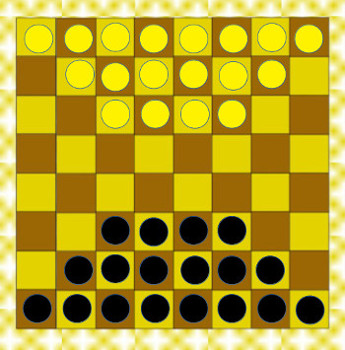Dameo
Written by Howard Fosdick © BestFreeNewGames.com
Overview: Dameo is a checkers variant that we include because so many players rate it highly. It was invented by Christian Freeling in 2000.
Dameo has only a few rules that differ from those of standard American checkers, but they change the game enormously.
Differences from Checkers:
Here are the only rules that differ between Dameo and standard American checkers:
1. Set up pieces as shown in the diagram below.
2. The pieces -- called "men" -- can move forward one square per turn, either straight ahead or diagonally.
3. Men can jump over one or more pieces of the same colour that are in front of them, either straight ahead or diagonally, providing that the square on the opposite side is unoccupied. (This gives the appearance that you're moving an entire line of pieces in one turn.)
4. Capture occurs vertically or horizontally only (never on a diagonal). A man may capture forwards, backwards, and sideways, as long as there exists an unoccupied square on the opposite side of the captured piece.
5. If a man ends his move on the furthermost rank of the opponent, that man is converted into a King. Kings move like Queens in chess, any number of vacant squares in one direction, either vertically, horizontally, or diagonally.
6. Kings may capture pieces located at a distance, as long as they have a clear path to that piece, and there is an unoccupied square on the opposite side. Like Men, Kings only capture orthogonally (not diagonally).
7. Jumping is mandatory. If alternative paths for jumping sequences exist, the player must take the one that captures the most enemy pieces. If jumping sequences are equivalent, the player may choose which to follow. Jumped pieces are removed only at the end of a turn. The same piece can not be jumped more than once in a turn.
Dameo Rules in Full:
Objective: You win the game either by capturing all enemy pieces, or by placing your opponent into a position where he can not move any piece. Should both players end up where neither can move a piece, the game ends in a draw. Draws also occur by mutual agreement.
Set Up:
Set up the board and playing pieces as shown in the diagram. Randomly decide who will take the first turn (alternate in subsequent games).

Play: In his turn, each player can move one piece.
Pieces move one square in any forward direction (towards the opponent) -- either vertically, horizontally, or diagonally. They can not move backwards, only forwards in the direction of your opponent.
A piece can jump over one or more pieces of its own colour, as long as all movement is in a single direction, and as long as there is an unoccupied space to which to jump. (This gives the appearance that you're moving an entire line of pieces in one turn.)
Jumping:
If your piece is next to an enemy piece and there is an open space on the other side, your checker must jump the enemy piece and land in the open square opposite. The enemy piece is removed from the board only at the end of your turn. Jumping occurs orthogonally only, never diagonally.
Jumping is mandatory. If more than one jump is possible for a piece, the player must take the jump sequence that results in the greatest number of captures. If two jump sequences are equivalent, the player may decide which to take.
Kings:
If one of your pieces resides on the most remote row of the board at the end of your turn, it becomes a King. Kings move like Queens in chess -- across any number of vacant squares either vertically, horizontally, or diagonally. Kings are subject to the same rules of mandatory capture as are Men. Like Men, they only capture orthogonally, not diagonally.
-----------------------------------
Tips for Play:
Since a piece can jump over a line of its own pieces, visually you have the ability to move a phalanx. This is termed linear movement in the game. The advantage is that you move your pieces together, retaining the group's strength.
Another result is that movement into combat is quicker than standard checkers, and the game, sharper.
The first side to King a Man secures a great advantage due to the greater mobility of Kings.
-----------------------------------
Print Your Own Game Board:
Want to print your own game board? We offer several different free images. Just
click here. You don't need to buy anything to try this game out!
If you like the game, we strongly recommend buying it from the inventor's company, MindSports. Rewarding and encouraging inventors is important, plus it's fun to play on a board that expresses their particular vision for their game.
-----------------------------------
Sources:
This game was invented by Christian Freeling and
his rules
are the ultimate authority on the game.
Here is a
very complete little booklet on the game
from his website.
Click here for more free games on this website.
-----------------------------------License: Feel free to print, copy, and distribute these rules, so long as you retain this paragraph. Written by Howard Fosdick © 2023, distributed under Creative Commons License BY-ND. HOME